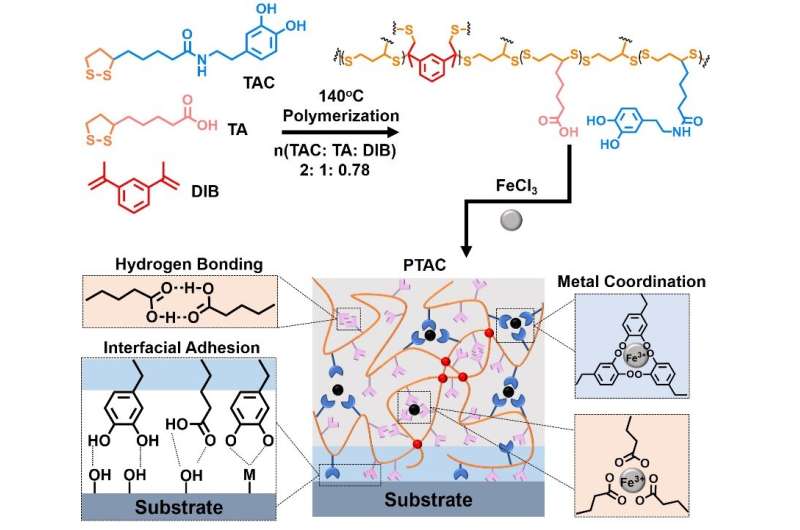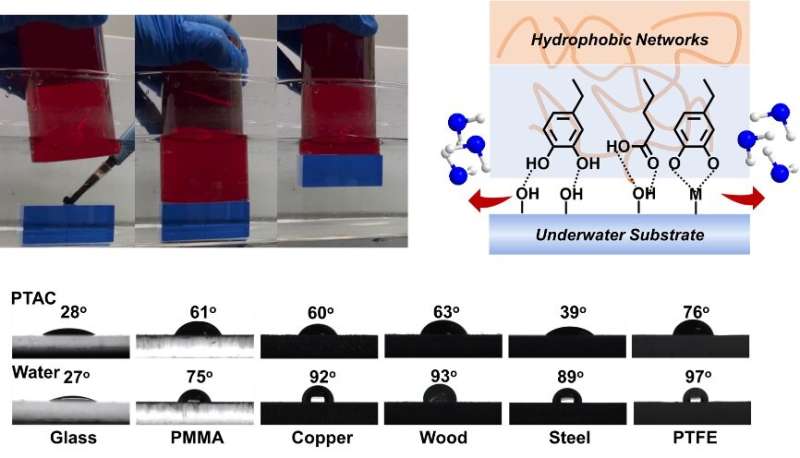Schematic representation of the monomer structures, synthesis conditions and polymer networks (top), and the cohesive networks and interface adhesion mechanism of the PTAC copolymer (bottom). Credit: Science China Press
Inspired by mussels' unique underwater adhesion ability, DOPA chemistry, which plays a key role in adhesive proteins, has become a typical supramolecular toolbox for designing water-resistant adhesive materials, resulting in elegant progress based on the scaffold of (hydro)gels. However, very few studies have focused on the DOPA-functionalized solvent-free network, which may enrich the supramolecular binding of DOPA moieties to the surface by avoiding solvation competition, and further boost the material performance of the bio-inspired adhesive material.
Prof. Da-hui Qu's group from East China University of Science and Technology has developed a series of solvent-free supramolecular networks by using thioctic acid (TA), a natural small molecule, as the feedstock. The reversible ring-opening polymerization (ROP) mediated by dynamic covalent disulfide bonds, together with the non-covalent crosslinking of sidechains, jointly endows the resulting network with many intriguing dynamic functions, including mechanical adaptiveness, self-healing ability, re-processability and chemical closed-loop recyclability.
Meanwhile, the resulting polymeric materials also show excellent adhesive properties, which may be attributed to (i) high interfacial penetration due to the small-molecule precursor, (ii) the high abundance of hydrogen bonds in the carboxylic sidechain and (iii) the solvent-free nature of the network. Motivated by this feature, researchers envisioned that it would be exciting if one could introduce mussel-inspired DOPA chemistry into the solvent-free network of poly(TA) so that the advantages of both adhesion chemistries could be combined in a single material that is a high-strength adhesive, while simultaneously being water-resistant, durable and dynamic.
In a study published in the National Science Review, the researchers report an unprecedentedly robust underwater adhesive material that incorporates TA based dynamic polymers and mussel-inspired adhesion chemistry. By modifying the TA sidechain with a catechol unit to obtain TAC monomers, the copolymer network of TA and TAC can be readily prepared and controlled by one-pot solvent-free ROP .
Photography of the instant adhesion of two glass blocks coated with PTAC copolymer adhesive in deionized water (Top left). Schematic illustration of the underwater adhesion mechanism (Top right). Contact angles of PTAC copolymer and water on different substrates (including glass, PMMA, copper, wood, steel and PTFE) (Bottom). Credit: Science China Press
The optimized supramolecular network exhibits dynamic properties as well as high-strength adhesion ability (shear strength >11 MPa). The robust interfacial adhesion shows excellent water resistance, durability and reusability. The unusual water-resistant interfacial adhesion ability suggests that the hydrophobic but polar PTAC network may induce interfacial water replacement upon adhesion, thus resulting in robust underwater adhesion.
This hypothesis is supported by the contact angles measurements of the molten PTAC copolymer and water on various substrates. Also, considering the biocompatibility of TA and the dynamic features of the material, this design strategy and its related materials will provide many opportunities in the design and application of wearable electronics and bio-adhesive materials.
More information: Chen-Yu Shi et al, Robust and dynamic underwater adhesives enabled by catechol-functionalized poly(disulfides) network, National Science Review (2022). DOI: 10.1093/nsr/nwac139
Provided by Science China Press

























